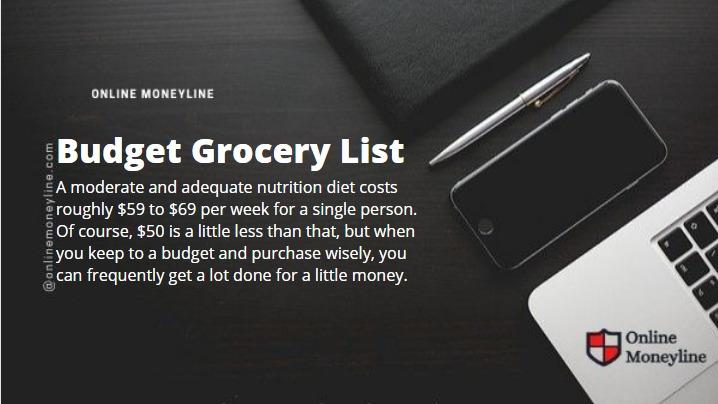I. What Can You Get For $50 Per Week Grocery? (40 Cheapest Groceries List)
According to the University of Otago, a moderate and adequate nutrition diet costs roughly $59 to $69 per week for a single person. Of course, $50 is a little less than that, but when you keep to a budget and purchase wisely, you can frequently get a lot done for a little money.
Here is the cheapest grocery list:
1) Oats
Oats are high in carbs, which is important if you require food to stay in your stomach for several hours. One serving of oatmeal provides your body with low fat, fibre, and a variety of other critical nutrients.
2) Bread
Health experts recommend whole-wheat bread. You can acquire 22 ounces of 22-slice bread for less than $2, which you may use to make sandwiches, pudding, or bread stuffing.
3) Broccoli
Broccoli is now on our list of the cheapest groceries for 2 purposes: it is a low-cost vegetable, averaging $1.64 a head, and that it’s high in essential nutrients like vitamin C. Broccoli is also high in antioxidants, folate, and vitamin K, which is why dietitians recommend it.
4) Lentils
Lentils are high in polyphenols, which are chemical compounds that help to improve blood flow by keeping capillaries flexible and strong. A half-cup of dried lentils costs $0.12, whereas a pound with the same costs $1.50.
5) Rice
Rice is indeed a popular food across the world, perhaps but it can be used in a variety of ways, such as rice salads, main dishes, soups, casseroles, and fried rice. Rice is deserving of a place on your budget grocery list since it provides important calories, fiber, and proteins for much less than $2.
6) Tomatoes And Onions
Tomatoes and onions are inexpensive year-round foods that are frequently priced fairly. You may be accustomed to onions being used to enhance the flavor of other foods, but you’ll be shocked to learn that the veggie may also be used to make a salad. Onions are high in antioxidants and minerals.
7) Potatoes
The average price of a pound of sweet potatoes is less than $1. Sweet potatoes are high on the list of low-cost foods that are high in critical elements, such as minerals and vitamins.
8) Peanut Butter
Peanut butter, to be precise. Many people keep peanut butter on hand for toast or other meals, but it can also be used as a food item when money is tight. An 18-ounce container of peanut butter provides enough carbohydrates and protein to meet your daily needs.
9) Cucumbers
If you’re a vegetarian, consider yourself fortunate since you can eat a wide variety of low-cost foods. Cucumbers are delicious, especially when combined with other vegetables in a salad.
Even yet, they’re filling on their own, thanks to their crunchiness and hydration.
10) Carrots
Carrots, especially baby carrots, are high in fiber and water. Such vegetables are filling and good for a flat stomach when eaten fresh. With a regular serving of baby carrots, you may say goodbye to metabolic issues.
Their beta-carotene and vitamin A content also help to improve skin and vision. We really had no justification for not including baby carrots in our cheapest grocery list since, well, they are the cheapest of all foods.
11) Eggs
When we really need a lot of protein and a healthy dosage of vitamin D, we turn to eggs. Then maybe the variety of servings and, of course, the low cost of eggs contribute to their popularity.
12) Slices Of Chicken Breast
I’m giving you even another reason to avoid buying a whole chicken that will most likely perish in the fridge. A full chicken costs around $10, however chicken breast strips price as little as $0.75.
This item should be on your cheapest grocery list because it will save you from fast-food nuggets while also keeping your body healthy.
13) Yogurt
A single serving of yogurt contains up to 15 grams of protein, whether this is Icelandic skyr or Greek yogurt. Yogurt with fat should not be avoided because it aids in the absorption of vitamin D.
14) Milk
Although milk doesn’t really fill your stomach, it is among the few inexpensive foods that will properly nourish the body. Instead, to increase the variety of nutrients in a single serving, you might add milk to vegetable smoothies.
15) Apples
Apples are a popular fruit in many households due to their high antioxidant content. Apples are not only inexpensive, but they are also ready to eat. You’ll still get a good dose of calories, fat, water, and protein if you add apple cubes to salads or not.
16) Cheese
Cheese is a good source of fat, protein, and calcium, much like all milk products. A 16-ounce cheese container also contains a lot of vitamins A and B-12, as well as phosphorus, riboflavin, and zinc.
17) Banana
Single banana fruit contains 105 calories, 14 grams of healthful sugar, fiber, and potassium for roughly 59 cents. The fruit is also high in prebiotic fiber, which aids digestion.
18) Coffee
Coffee has no calories, and it also has no fat, cholesterol, or sugar. A hundred grams of coffee contains 2 milligrams of sodium and 49 milligrams of potassium, both of which are necessary minerals for good health. Every one of the health benefits is fantastic, but coffee’s true value lies in its capacity to save you cash when brewed at home.
19) Frozen Vegetables
Frozen vegetables can also be a cost-effective solution, especially when other favorite vegetables are out of season. And, contrary to popular belief, vegetables lose little to no nutritious value while frozen, according to what I’ve read.
Casseroles, soups and stews, omelets, and other dishes benefit from frozen vegetables. Are doing a preliminary comparison of serving sizes to see whether frozen vegetables are indeed a better price.
20) Cabbage
Cabbage would be not only widely available, but it’s also flexible, and it’s high in nutrients. Vitamins C, A, and K, fibre, folate, and a significant amount of non-digestible carbohydrates (prebiotics) are all available for much less than 30 cents.
21) Kiwi
Another budget-friendly alternative is this sweet, delectable fruit, which is in season during the summer months. As during summer, we can usually purchase three or four for just a dollar at our nearby grocery shop. Kiwis are high in vitamin C and fiber, and they’re delicious on their own or in a fruit salad.
22) Soybeans
Soybeans, also known as frozen edamame, are a budget-friendly grocery item that may be served as an appetizer or side dish.
Whenever soybeans are removed from their pods and used in casseroles, stews, or fried rice, they make a rich and nourishing gravy. Soybeans provide iron, calcium, fiber, and necessary calories, in addition to flavor.
23) Kale
Kale has been one of the healthiest vegetables available, making it an excellent investment. It’s full of antioxidants like vitamin A, C, and K, iron, and potassium, calcium, fiber and costs roughly $1 to $1.50 per bunch at our nearby grocery shop.
24) Peanuts
Peanuts may not have the nicest reputation, but when consumed in moderation, they provide a wealth of nutrients. Nuts give healthful fats as well as the other advantages that legumes provide.
With one dollar, you can get a bag of 60 nuts, and for much less than $5, you can get an eight-ounce bag.
25) Bell Pepper
If you’re a veggie, up an entire bell pepper is a must-have ingredient in your smoothie. Vitamin C is abundant in this crisp vegetable, which aids muscle building.
26) Millet
Millet has an incredible nutritious load for its price, which is around $3 per pound on average. You also have a variety of meal plan options to choose from, all of which will ensure that you get a good dose of vitamin B.
27) Yogurt
A single serving of yogurt, whether Icelandic skyr or Greek yogurt, contains up to 15 grams of protein. Yogurt with fat should not be avoided because it aids in the absorption of vitamin D.
28) Garlic
Garlic is a fantastic taste enhancer to include on your budget grocery list, costing about 50 cents or less per bulb. Garlic is a good source of vitamins B and C, as well as minerals like copper, iron, manganese, and potassium.
29) Sugar
Sugar is a low-cost, basic supermarket item that should not be overlooked on your low-cost shopping list. Sugar costs around 50 cents per pound, depending on the applicable grocery store.
30) Pasta
Pasta is indeed a versatile food that may be topped with butter, sauce, or cheese, and that is one of the cheapest consumables to purchase in college. Pasta is a wonderful source of fiber, energy, and can assist with cholesterol and stomach issues because it is made from grain.
A pound of pasta costs roughly a dollar. Pasta is an inexpensive method to stretch the meat component of dinner, costing as little as a dollar per pound.
31) Chickpeas
Because chickpeas are abundant in protein, they make a good meat substitute in vegan diets. It also contains a lot of fiber, vitamins, and minerals. Chickpeas, when eaten like half of a well-balanced meal, can aid digestion and weight loss.
32) Pork
Pork is a low-cost source of protein, vitamins, and minerals like phosphorus, iron, and zinc. It’s a terrific substitute for red meats like beef and lamb, especially when you’re on a low-carb diet.
33) Salsa
Salsa is high in vitamin C and fiber, and it’s low in calories but high in flavor. Salsa is much less expensive when purchased pre-made rather than created from scratch.
34) Edamame with Tofu (Soy)
Soy protein can be found in edamame and tofu. Soybeans, whether it is in the form of edamame or tofu, are a healthy snack or side dish.
35) Mushrooms
Mushrooms are a great side dish that may be served with chicken, spaghetti, or your favorite stir-fry combination. You won’t be leaving them off your grocery list because they’re so flavorful!
36) Ground Beef
The most expensive ingredient on just this list is ground beef, but it really is simple to work with and could be frozen or cooked ahead of schedule for fast meal planning or prep. In addition, a $3 pound of ground beef may go a long way in sauce.
37) Ground Turkey
Serve the ground turkey over freshly boiled spaghetti for a quick, protein-packed supper. Tacos and wraps made with ground turkey are also tasty.
38) Cookies
If you’re seeking something sweet, practically every grocery shop will have a package of cookies for under $2.
39) Frozen Fries
Frozen french fries are quick and easy to prepare, and they can add a lot of flavor to grilled or baked chicken. Toss them inside the oven with a little oil and serve with your kids’ favorite vegetables.
40) Zucchini
Zucchini is a moderate vegetable that may be used in a variety of recipes. It goes a very long way when it comes to food preparation!!
II. The Cheap Grocery List—Table
Let’s Have A Look At The Cheap Grocery List
| Food Items | Price |
| Coffee | $3.79 |
| Milk (1/2 Gallon) | $1.65 |
| Ranch Dressing | $0.89 |
| Cheese (2 blocks) | $3.38 |
| Peanut Butter | $1.15 |
| Tortillas | $0.99 |
| Wheat Mini Bagels | $1.89 |
| Baby Carrots | $0.79 |
| Refried Beans | $0.75 |
| Cucumbers (3) | $1.47 |
| Sour Cream | $0.89 |
| Eggs (2 dozen) | $2.98 |
| Taco Seasoning | $0.29 |
| Apples (3 lb bag) | $2.39 |
| Spread Butter | $2.29 |
| Bananas (2 lbs) | $0.88 |
| Potatoes (5 lb bag) | $1.99 |
| Frozen Broccoli | $1.19 |
| Frozen Stir Fry Veggies (sauce packet included) | $2.99 |
| Rice | $1.79 |
| Wheat Bread | $1.79 |
| Canned Soup | $1.19 |
| Salsa | $1.19 |
| Boneless Skinless Chicken Breast (2 lbs) | $3.96 |
| Boneless Ham (2 lbs) | $6.98 |
| Total | $49.54 |
Recommended: See how you can create your budget using our sample budget for a family of 5.
III. Suggestions For Keeping To Your Grocery List
01. Make a menu strategy for the entire week
Plan out the week and consider how you’ll eat today, lunch, and dinner when you go grocery shopping. Are you still stuck? Take your partner or children with you and get together. The idea is to prevent you from purchasing unneeded buys that you will never use
02. Once You’ve Cooked It, Eat It Twice
In my opinion, this is the best way to save money and time. Pick two dishes that will provide sufficient leftovers for two nights’ dinners or a week’s worth of lunches. Although you may find yourself spending extra time cooking one night, your future would appreciate it.
03. Use Ingredients In A Variety Of Ways
When planning your weekly menu, try to think of ways to combine items in different ways. Perhaps you purchase tomatoes for just lunch salads and afterward roast the remainder for pasta or as a fish topping.
1⁄2 a bag of spinach can be used in quesadillas, as well as the rest, can be blended into a pesto. This is in which you can truly let your imagination run wild. However, how many different ways do I use a component this week? It was almost like a game.
IV. Meal Plan For $50
Breakfast
- For breakfast you can take a cup of coffee with one mini whole- bagel.
- Banana Omelette.
- Whole-wheat bread with cheese, peanut butter or spread butter.
- One cup of Milk and an apple or banana.
Lunch
- Boneless Chicken with salad.
- Mashed potatoes, with Taco seasoning
- Salsa with Taco seasoning and wheat bread or tortilla.
- Cheese and Refried bean with a side of sliced apple
Dinner
- Frozen stir fry veggies soup
- canned soup
- Chicken and Egg soup
- Boneless Ham with salad
- boiled rice with salad and Broccoli
- Grilled chicken with salsa, and salad
FAQS: Budget Grocery List
What Are The Cheapest Groceries You Can Buy?
Rice, chicken, canned soup, sugar, Lentils, onion, tomato, milk, yogurt, bread, cottage cheese, banana, cucumber, carrots, eggs, pasta, ground beef, broccoli. These are some of the cheapest and healthiest foods that you can buy if you are on a tight budget.
Is $200 A Month Enough For Groceries?
It’s a lot of money to spend $200 a month on meals! That works out to $6.66 per day, which can get you a lot of different things, including some more expensive items if you don’t eat out or shop at places like Whole Foods. You’ll be alright without ever even trying when you just buy products that are on sale. So $200 will cover a month’s worth of groceries.
How Do You Buy Groceries On A Tight Budget?
Also, read how to take care of a baby on a budget.
One of the simplest methods to cut your food bill is to plan your meals ahead of time. Boneless, skinless chicken breasts are, without a doubt, easier to handle and look at. Having a price book will assist you in determining whether or not an item is truly on sale. Make-ahead meals could also be frozen.
It would not only save you the time upon these hectic school nights, but it would also save you cash because you have planned ahead. Keeping your own versions of easy recipes on hand so you can make a fast, quick, and frugal supper almost any week of the year.





